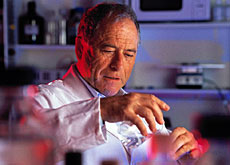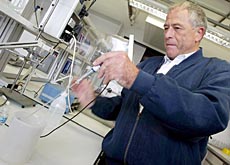New accolade for Nobel prize winner

Nobel prize laureate, Kurt Wüthrich, was last week made an honorary fellow of Britain’s Royal Society of Chemistry.
The man who mapped the prion protein, implicated in Mad Cow disease, told swissinfo that his decision to become a chemist was largely an accident.
Wüthrich literally stumbled into a scientific career after a foot injury put paid to his ambitions to be a footballer.
He is now one of the world’s most eminent scientists for his work in determining the structure of prion proteins. These are implicated in the fatal brain illnesses, Mad Cow Disease (or BSE), and its human equivalent, Creutzfeld-Jakob Disease (CJD).
Wüthrich’s work earned him the Nobel Prize for Chemistry in 2002, and last week he was welcomed into the Royal Society of Chemistry for pioneering a way to map macromolecules.
In simple terms, Wüthrich developed a new way of visualising such molecules in three dimensions.
This has enabled researchers to better understand how they work in the body’s cells, and has helped in the development of new and more effective drugs as well as improved diagnostic tools.
In London, last week Wüthrich gave a talk on his main topic of research – prion proteins and their connection to BSE and CJD.
swissinfo: How does it feel to be given the fellowship?
Kurt Wüthrich: It’s a very nice recognition and I’m quite proud of being included. I should emphasise, however, that I am being invested into the Royal Society of Chemistry as a chemist who has developed a new method for structure determination of macro-molecules rather than for the work on prion diseases, which is just one of many applications of our technique.
swissinfo: Looking at your biography, you’ve studied chemistry, physics and mathematics. You’ve also studied sports and you seem to have had a varied early career. What led you to specialise in chemistry?
K.W.: The reason why I concentrated on science is that I broke my right foot, which prevented me from performing in soccer as I used to. So I had to do something else for a couple of years, so I got a few degrees from the university.
swissinfo: Let’s move on to prion diseases. What makes them different to other diseases such as those caused by bacteria or viruses?
K.W.: At this point, there is a hypothesis that prion diseases are caused by a protein which changes its shape and in doing so becomes an agent that causes disease. Whether that is indeed correct remains to be seen. This is an open question and that’s why I’m still spending a good part of my activity in this area.
swissinfo: How does the prion protein work, and how does the disease spread?
K.W.: In the late stages of a prion disease in mammals you find the [malformed] protein in aggregated form in deposits in the brain [and] it is these deposits that mechanically destroy the brain functions.
swissinfo: Your talk in London this week focused on the remaining unknown aspects of the causes or mechanisms of prion disease. What is it that we still don’t know?
K.W.: How the disease develops is not clear and that is subject to current research. And it can be expected that finding out about the natural function of the prion protein could advance the field in a dramatic way.
swissinfo: Is there still any doubt over a direct link between mad cow disease and Creutzfeld-Jakob Disease in humans?
K.W.: According to the prevailing dogma, there should in principle not be transmission between different species, so we should be safe in ingesting infected beef material in that it should not make us sick.
Now it appears that this species safety barrier has been breached in a certain number of cases. So that probably after ingesting infected beef, humans were infected with a prion disease, which differs from the classical Creutzfeld-Jakob Disease and has traits that are reminiscent of BSE.
There is strong evidence that this transmission has occurred in a limited number of cases. We were all afraid that this would turn into an epidemic among humans. At this point, we can still hope that this will not be the case and the outbreak will die out without involving a large number of human beings.
swissinfo: Will it be possible in the future to find a cure for the disease or will we only ever be able to prevent it?
K.W.: At the moment, a lot of effort is spent on early diagnosis. I think the discovery of drugs that would lead to a treatment or even inoculation against the disease is still quite a long way ahead. There are clearly reports of progress as far as diagnostics are concerned.
swissinfo: It may be said that you’ve reached the pinnacle of your career, with the Nobel Prize for Chemistry under your belt. What do you plan to do next?
K.W: I have built up a second laboratory in California and so for the next few years I will have two working laboratories – one in the Federal Institute of Technology in Zurich and the other one, at the Scripps Research Institute in La Jolla in California. In California, I will pursue work in proteomics. In Zurich, one of the prime goals will be to gain an insight into the mechanisms that govern the onset of prion diseases.
swissinfo-interview: Joanne Shields
Born in Aarberg in 1938, Wüthrich studied chemistry, physics and maths as well as sport.
He was awarded his PhD in inorganic chemistry in 1964.
He has been at the Federal Institute of Technology in Zurich since 1969 and now divides his time between Zurich and California.
Wüthrich won the Nobel Prize in Chemistry 2002.

In compliance with the JTI standards
More: SWI swissinfo.ch certified by the Journalism Trust Initiative



You can find an overview of ongoing debates with our journalists here. Please join us!
If you want to start a conversation about a topic raised in this article or want to report factual errors, email us at english@swissinfo.ch.